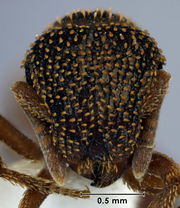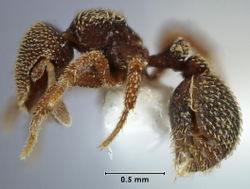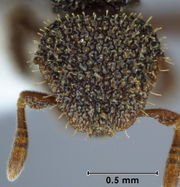Key to Calyptomyrmex of Southeast Asia and Oceania
This worker key is based on: Shattuck, S.O. 2011. Revision of the ant genus Calyptomyrmex in South-east Asia and Oceania. Zootaxa. 2743:1-26.
You may also be interested in
1
- Hairs on head and body spatulate (noticeably narrower near the body and expanded distally and with a rounded tip) . . . . . 2
- Hairs on head and body thin (essentially the same width along entire length, or only slightly and gradually expanded distally, and with blunt tips) . . . . . 8
2
return to couplet #1
- Gaster with low longitudinal striations running between the spatulate hairs (Australia) . . . . . . Calyptomyrmex fragarus
- Gaster smooth to shallowly punctate . . . . . 3
3
return to couplet #2
- Propodeum armed with short angular teeth . . . . . 4
- Propodeum unarmed . . . . . 6
4
return to couplet #3
- In dorsal view node of petiole much broader than long and rectangular in shape; body smaller (HW < 0.82mm) (Australia) . . . . . Calyptomyrmex fritillus
- In dorsal view node of petiole only slightly broader than long and oval in shape; body larger (HW > 1.00mm) . . . . . 5
5
return to couplet #4
- Body larger (HW > 1.12); head longer than broad (CI < 98); spatulate hairs on posterior section of head and mesonotum appressed closely to the underlying body surface; propodeal spines larger and more strongly angled (angle between faces approximately 90°) (Australia) . . . . . Calyptomyrmex sparsus
- Body smaller (HW < 1.12); head broader than long (CI > 104); spatulate hairs on posterior section of head and mesonotum rising above the underlying body surface; propodeal spines shorter and broader (angle between faces greater than 90°) (Malaysia) . . . . . Calyptomyrmex danum
6
return to couplet #3
- Hairs on head narrowly spatulate and rising well above the underlying body surface; in dorsal view node of petiole rectangular, in lateral view relatively thin; body smaller (HW < 0.82mm) (Australia) . . . . . Calyptomyrmex taylori
- Hairs on head broadly spatulate and appressed closely to the underlying body surface; in dorsal view node of petiole rounded, in lateral view relatively thick; body larger (HW > 0.90mm) . . . . . . 7
7
return to couplet #6
- Posterior margin of head above the level of antennal scrobes broader, the lateral corners more angular; body larger (HW > 1.13mm); spatulate hairs broader and more rounded (Malaysia, Philippines) . . . . . Calyptomyrmex loweryi
- Posterior margin of head above the level of antennal scrobe narrower and the lateral corners more rounded; body smaller (HW < 1.10mm); spatulate hairs narrower and more linear (widespread) . . . . . Calyptomyrmex beccarii
8
return to couplet #1
- Gaster heavily sculptured with striations or a network of low rugae . . . . . 9
- Gaster weakly (and sometimes indistinctly) punctate . . . . . 10
9
return to couplet #8
- Sculpturing on gaster consisting of a network anteriorly and striations posteriorly, the individual rugae very closely spaced; body larger (HW > 1.20mm) (Australia) . . . . . Calyptomyrmex lineolus
- Sculpturing on gaster a series of widely spaced longitudinal striations; body smaller (HW < 1.00mm) (Malaysia) . . . . . Calyptomyrmex retrostriatus
10
return to couplet #8
- Propodeum lacking or essentially lacking spines or angles (although slightly convex rugae may be present near the angle) (Malaysia) . . . . . 11
- Propodeum armed with short, triangular or narrow spines . . . . . 12
11
return to couplet #10
- Lateral surfaces of mesosoma and dorsal surface of head with a limited number of well defined, broad rugae which are well separated; hairs on mesonotum relatively short and tending to be weakly spatulate; petiolar node in dorsal view only slightly wider than long (PetI approx. 115); body larger (HW > 1.05mm) . . . . . Calyptomyrmex asper
- Lateral surfaces of mesosoma and dorsal surface of head with numerous narrow, ill-defined rugae which are more closely spaced; hairs on mesonotum relatively long and only slightly swollen distally; petiolar node in dorsal view noticeably wider than long (PetI > 130); body smaller (HW < 1.05mm) . . . . . Calyptomyrmex ryderae
12
return to couplet #10
- Setae on leading edge of scape long, about as long as scape width; propodeal spines broadly triangular; legs rugo-reticulate (Malaysia) . . . . . Calyptomyrmex sabahensis
- Setae on leading edge of scape short, shorter than scape width; propodeal spines narrower and more spine-like; legs punctate . . . . . 13
13
return to couplet #12
- Mesonotum and dorsal face of propodeum forming a single, continuous surface; petiolar node more upright and block-like, in dorsal view longer than broad (New Caledonia) . . . . . Calyptomyrmex caledonicus
- Mesonotum and dorsal face of propodeum separated by an angle; petiolar node leaning slightly posteriorly, the anterior face rounding into the dorsal face, in dorsal view broader than long . . . . . 14
14
return to couplet #13
- Rugae on dorsum of head widely spaced, the underlying punctate surface clearly visible, the rugae fading posteriorly and essentially absent near the posterior margin (Vietnam) . . . . . . Calyptomyrmex rectopilosus
- Rugae on dorsum of head closely spaced and largely obscuring the underlying surface, the rugae strongly developed across the entire length of the head (Australia) . . . . . 15
15
return to couplet #14
- Mesonotum rugo-reticulate but with rugae running longitudinally; propodeal spines shorter; petiolar node in dorsal view broader and thinner . . . . . Calyptomyrmex grammus
- Mesonotum rugo-reticulate but lacking longitudinal rugae; propodeal spines longer; petiolar node in dorsal view narrower and thicker . . . . . Calyptomyrmex ocullatus































